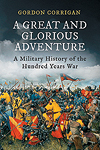
A Great and Glorious Adventure: A History of the Hundred Years’ War and the Birth of Renaissance England, by Gordon Corrigan, Pegasus Books, New York, 2014, $27.95
In 1801 Britain’s George III dropped his claim to the French throne, a pretension prosecuted with varying degrees of enthusiasm by 19 predecessors. Thus opens British military historian Gordon Corrigan’s engrossing history of a long and nasty war.
Most readers recall from their history books that William I ruled Normandy before conquering England in 1066. His successors expanded these holdings until, under Henry II (1133–89), they ruled an area greater than that of the French king. When Philip IV of France died in 1314, his three sons each ruled a few years before dying, leaving only their sister, Isabella, in line for the throne. Both nations’ laws were silent on the matter of a ruler’s sex, and the French had always managed to find an available male. That Isabella was married to King Edward II of England did not help her case. French nobles preferred Philip IV’s nephew. Isabella’s claim was no secret to her son, Edward III (1312–77) who declared himself France’s ruler in 1337, launching the Hundred Years’ War.
Corrigan is at his best explaining the nuts and bolts of medieval warfare. It cost a great deal of money, which in Britain’s case had to be raised by an often-sullen Parliament. The weaker French monarchy called on traditional feudal levies and depended heavily on mercenaries. Soldiers often went unpaid and unfed, though the perk of looting kept grumbling to a minimum. While armored mounted knights formed the traditional feudal army, centuries of crude combat in Wales and Scotland had since persuaded the English that dismounted troops were more nimble and wielded greater firepower—notably the celebrated longbow, whose arrows could penetrate armor.
England’s victories at Crecy (1346), Poitiers (1356) and Agincourt (1415), however, were fought on the defensive. They also proved meaningless, as England lacked the resources to exploit its triumphs. A decade after Agincourt, Joan of Arc (1412–31) arrived, and France got its act together. A stronger monarchy soon professionalized the army, which began winning. By war’s end in 1453 England held only the city of Calais.
English armies began campaigns by ravaging the French countryside, hoping to persuade citoyens their government could not protect them, though this hardly came as news to the French, whose rulers required months to assemble an opposing force. Intervening decades of relative peace instead featured famine, plague, dynastic bloodshed and internal revolts in both nations. Corrigan devotes only modest space to battle accounts, but readers will enjoy his lucid explanations of how wars were financed and fought—as well as the Byzantine politics and often-unpleasant personalities who conducted them.
—Mike Oppenheim




